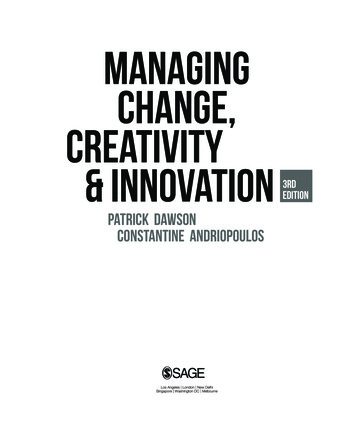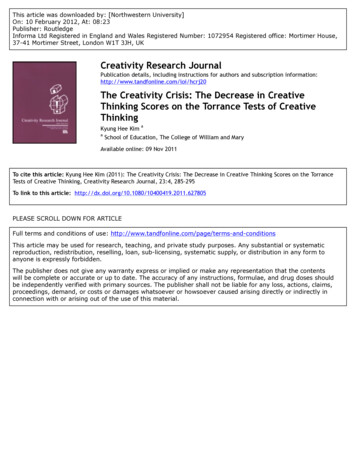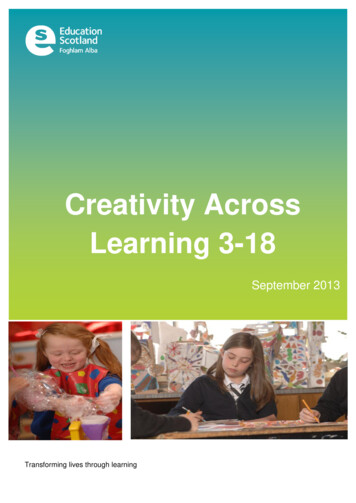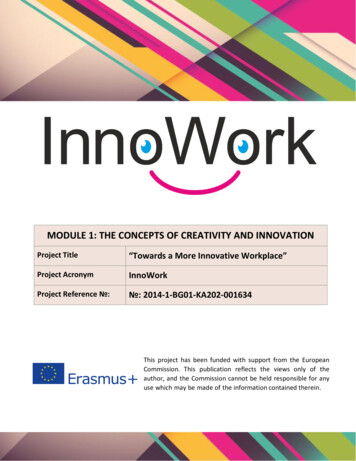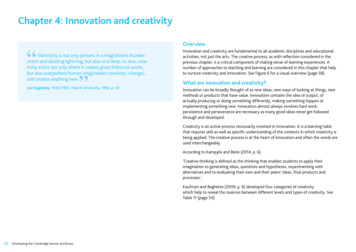
Transcription
Chapter 4: Innovation and creativityOverviewElectricity is not only present in a magnificent thunderstorm and dazzling lightning, but also in a lamp; so also, creativity exists not only where it creates great historical works,but also everywhere human imagination combines, changes,and creates anything new.Lev Vygotsky, 1930/1967, cited in Smolucha, 1992, p. 54Innovation and creativity are fundamental to all academic disciplines and educationalactivities, not just the arts. The creative process, as with reflection considered in theprevious chapter, is a critical component of making sense of learning experiences. Anumber of approaches to teaching and learning are considered in this chapter that helpto nurture creativity and innovation. See Figure 6 for a visual overview (page 58).What are innovation and creativity?Innovation can be broadly thought of as new ideas, new ways of looking at things, newmethods or products that have value. Innovation contains the idea of output, ofactually producing or doing something differently, making something happen orimplementing something new. Innovation almost always involves hard work;persistence and perseverance are necessary as many good ideas never get followedthrough and developed.Creativity is an active process necessarily involved in innovation. It is a learning habitthat requires skill as well as specific understanding of the contexts in which creativity isbeing applied. The creative process is at the heart of innovation and often the words areused interchangeably.According to Kampylis and Berki (2014, p. 6):‘Creative thinking is defined as the thinking that enables students to apply theirimagination to generating ideas, questions and hypotheses, experimenting withalternatives and to evaluating their own and their peers’ ideas, final products andprocesses.’Kaufman and Beghetto (2009, p. 6) developed four categories of creativitywhich help to reveal the nuances between different levels and types of creativity. SeeTable 11 (page 54).53Developing the Cambridge learner attributes
Chapter 4 continuedTable 11: Four categories of creativityBig-C creativity (sometimescalled ‘high’ creativity)Big-C creativity is reserved to describe the work of an elite few who have transformed their discipline with their inventions. Their work hasbeen generally accepted as being innovative and ground-breaking, even if it was considered controversial when it was first created. Someexamples are scientific works such as Einstein’s theory of relativity and Darwin’s theory of evolution, and works of art such as Picasso’sGuernica, Jane Austen’s novel Emma or Ludwig van Beethoven’s Symphony No. 9 in D Minor. Big-C creativity is out of reach of most of us,and big-C creators themselves are often as extraordinary as their creations.Pro-c creativityThis type of creativity has involved time (usually at least 10 years) and effort to develop. A musician who showed promise as a child, hastrained to degree level and now makes a living teaching and playing classical music could be classified as pro-c. A physicist working at auniversity who teaches and undertakes academic research could also be classified as pro-c.Little-c creativityLittle-c creativity is about ‘acting with flexibility, intelligence and novelty in the everyday’ (Craft, 2005, p. 43). This results in creatingsomething new that has ‘originality and meaningfulness’ (Richards, 2007, p. 5). This everyday kind of creativity can be found in the kind ofperson who can resolve a complex problem at work, is a keen gardener with an eye for design, or takes creative photographs and exhibitsthem on a photo-sharing website. School-age learners may work at little-c level if they engage in purposeful practice in their discipline.Little-c creativity involves practice and may be developed over a long period of time. The internet has provided the infrastructure for little-ccreativity to thrive. Websites such as YouTube, Instagram and Etsy enable creative people to share their expertise and work.Mini-c creativityMini-c is defined as the ‘novel and personally meaningful interpretation of experiences, actions, and events’ (Beghetto & Kaufman, 2007, p.73). This is the kind of creativity that can be nurtured by teachers and parents. ‘Mini-c happens when a person demonstrates “flexibility,intelligence and novelty” in their thinking’ (Craft, 2005, p. 19). It is usually applied, but not necessarily limited, to children’s creativity.Mini-c creativity may not be visible to outsiders and may consist purely of ideas and connections that the learner creates. As Vygotsky(1967, p. 7) explains: ‘Any human act that gives rise to something new is referred to as a creative act, regardless of whether what isconstructed is a physical object or some mental or emotional construct that lives within the person who created it and is known only tohim.’ Piaget suggested that ‘to understand is to invent’ (1976, cited by Richards, 2007, p. 95) meaning that a learner ‘invents’ anunderstanding of new material for themselves. Mini-c creativity could describe a learner’s achievement in finding several different ways ofapproaching a maths problem. It could also involve making a new connection between their existing knowledge and a new piece ofinformation which helps them to understand the subject more fully.54Developing the Cambridge learner attributes
Chapter 4 continuedThe boundaries between these categories can be blurred and they are not age specific.A person could fit into multiple categories in different areas of their life. For example, achef who could produce dishes at a pro-C level while at work might work at a little-clevel when attending a watercolour painting class.The two categories most relevant to schools are little-c and mini-c creativity. Theyhighlight the fact that being creative and innovative is not so much about revolutionaryideas or new inventions that change the world. It is about individual growth achievedthrough small insights. Creativity and innovation are fundamental to all disciplines andan essential part of the learning process, forming an important dimension of learninghow to learn, which we considered in Chapter 3. They are also fundamental to teachersimproving their professional practice and to school development.Being innovative and creative is dependent on the other attributes. Being creativerequires reflection, encourages engagement and develops confidence and responsibility.The ability and inclination to be creative is essential to living a fulfilled and successfullife, and it is valued in higher education and the workplace. There are many otherbenefits of maximising one’s own creative potential such as physical and psychologicalhealth improvements, improved resilience in the face of difficulties and even lowerlevels of aggression (Richards, 2007, p.9).Craft (2005, p.15) points out that our understanding of innovation and creativity haveprogressed and broadened over time. In the early 20th century creativity wasconsidered to be an innate, elusive quality that individuals were born with. Initiallycreativity was most closely associated with the arts but grew to include science,technology and other disciplines. In the 21st century creativity is increasingly viewed asa distributed and collaborative process of communal sense making and problem solving.As with all the learner attributes, cultural perspectives are also very important whenconsidering creativity. Confucian heritage cultures, for example, tend to see creativitymore as a collective exercise. They place responsibility for creativity on the social grouprather than the individual. Individuals, therefore, are not encouraged to stand out fromthe class in the same way or to the same extent as in Western cultures. This does notmean that creativity is in any way less valued. As with all the learner attributes, ideaspresented in this chapter need to be interpreted and implemented in a culturallysensitive way.55Developing the Cambridge learner attributesCreativity, innovation and learningAs discussed in Chapter 1, learning involves challenging, refining and improvingunderstanding by being made to think hard. Sometimes, to understand new conceptsand broaden perspectives, our approaches to thinking need to be creative, imaginativeand lateral (incorporating new ways of looking at things), as well as linear (using existingpatterns of thought).One characteristic of the creative process that makes it particularly powerful is thatit requires not only knowledge and understanding of the domain being investigated,but also a willingness to question and not be constrained by existing knowledge.Learners should understand how they can question or challenge established knowledgeto help them to formulate their own understanding, and imagination can play animportant role:‘One cannot think creatively unless one has the knowledge with which to thinkcreatively. Creativity represents a balance between knowledge and freeing oneself ofthat knowledge’ (Johnson-Laird, 1988, p.207, cited by Sternberg, 2012, p.4).For creative thinking to deepen and extend learning, rather than be an enjoyable butsuperficial activity, it must be grounded in understanding of the content beinginvestigated. It is vital that learners have sufficient understanding of the material withwhich they are being asked to be creative. Creative practice needs to complementdiligent and deliberate practice that develops foundational skills – not be a substitutefor it.A revised version of Bloom’s original 1956 taxonomy by Krathwohl (2002, p.212–218;see Figure 4) includes creativity in the taxonomy and places creativity above evaluationas a higher order thinking skill. An alternative, and probably more accurate,representation would be to include creativity as a process involved in skills at all levelsrepresented in the taxonomy, and increasingly so with higher order skills. It might bethought that remembering factual information does not involve creative processes. Infact, as the section later in this chapter on mind maps reveals, creative approaches canbe very helpful in remembering information. The processes used by champions at theWorld Memory Championships are highly creative as they use the mind’s capacity torecognise and remember chunks or patterns that have meaning to the individual muchmore effectively than isolated facts.
Chapter 4 continuedCreative learning activities, like any other, need to respect Vygotsky’s zone of proximaldevelopment with appropriate scaffolding provided by the teacher. willingness to take sensible risks or go out of their comfort zone in their work.A creative learner needs to be able to develop and apply a set of skills that they can usein the creative process. These include being able to: clarify, analyse and re-define the problem or question to uncover newways of looking at it ask thoughtful questions notice connections between seemingly unrelated subject matter challenge established wisdom by asking: how would I improve this? recognise alternative possibilities look at things from different perspectives.Creative processes usually require self-regulation, and the ideas relating toreflection and metacognition considered in Chapter 3 apply. These include learners:Figure 4: A revised version of Bloom’s taxonomyThis is an area in which cultural sensitivity may be particularly important. If studentsare not used to being asked to demonstrate creative habits and skills they need to beguided. How the creative activity links to broader learning objectives needs to be clearlyunderstood by teachers and students.Having a creative habit, the disposition to behave creatively is critical. Csikszentmihalyi(2002, p.99) emphasises the importance of having a playful attitude while remainingdisciplined. Whenever possible, play should be used to extend the range ofopportunities to think. There are several character traits and learning habits that affecta learner’s personal disposition, motivation and confidence to be creative. For example: resilience: an ability to tolerate uncertainty and persevere at a task to overcomeobstacles not being afraid to make and learn from mistakes an ability to suspend judgement while generating ideas56Developing the Cambridge learner attributes being aware of their own skills, both strengths and limitations thinking of a range of different strategies or approaches to use in response to aproblem or question planning which approach to use monitoring their work, and being flexible enough to change to a different approachif necessary critically evaluating their work at appropriate pointsCreating a culture of creativity in schools and classroomsWe are all born with a creative instinct and all people have creative potential. Youngchildren naturally engage in play – a state when the imagination is usedto ‘try out’ situations and possibilities. A cardboard box becomes a car, grass becomesfood, a toy comes alive. As children mature and move through their school career,creativity can be stifled as an unintended consequence of other pressures. Students canbecome fearful of making mistakes if they only receive recognition for giving an answer
Chapter 4 continuedthe teacher is looking for rather than valid original thinking and ideas. A study oncreativity and innovation in education in European member states (Craft, 2005, p.21)found that teachers preferred their learners to be ‘conforming’ or ‘considerate’ to ‘risktaking’ and ‘playful’ (Ferrari, Cachia & Punie, 2009, p.21). A culture of ‘one right answer’stops learners from being willing to make mistakes. They quickly learn to guess whatanswer the teacher has in their heads. As von Oech (1998, p.14) points out, ‘many of ushave been taught that the best ideas are in someone else’s head’.Figure 5: A creativity orientationLike any habit, creativity can be encouraged or discouraged. Having a learning ratherthan a performance orientation, considered in Chapter 3, helps to create anenvironment where creativity is encouraged. Schools that are successful at stimulatingcreative learning: value and celebrate learners’ creative and innovative contributions do not overcrowd the curriculum. They focus on depth as well as breadth.They manage time effectively, providing opportunities for pupils to explore,concentrate for extended periods of time, reflect, discuss and review. Students areexpected to reflect deeply on the material that they are learning and to makeconnections between subjects and topics encourage a broad and balanced curriculum so that students experience a range ofsubjects and activities, including the arts encourage students not studying the arts as qualifications to pursue creativeactivities in the co-curricular programme develop codes of behaviour and classroom procedures that value andpromote creativity encourage sensible risk taking, for example, teachers trying something new intheir lessons.The creative process requires time and collaboration, so creating time for creativethinking activities is important. Using a flipped classroom approach for example, wherelearners prepare content and do written exercises preparing for lessons in advance athome, allows teachers to plan for higher-level creative thinking activities during classtime. Another approach that helps students to make connections across topic areas and57Developing the Cambridge learner attributesunderstand the discipline as a whole is spaced delivery of content in lessons. Thisinvolves teachers revisiting related subject matter over a long time rather than justteaching each topic as a separate entity.Creating a climate in the school by providing an environment that supports innovationcan be very powerful, as Case study 10 shows:
Figure 6: Visual overview of innovation and creativityChapter 4 continuedFigure 6: Visual overview of innovation and creativity (Hover your mouse over the image to enlarge)58Developing the Cambridge learner attributes
Chapter 4 continuedCase study 10:St. Andrew’s Scots School, Buenos Aires, Argentina – The Learnerspace: a new pedagogy by designWatch the video athttps://vimeo.com/228213052Makerspaces have become ubiquitous in schools all over the world to encouragestudents to apply creativity and critical thinking through design. A similar approach tolearning, transforming a traditional environment into a Learnerspace can also be agreat catalyst for moving pedagogy towards a learner-centred model.Of all the many spaces in school, the school library lends itself to becoming anemblem for a new learning paradigm. In that context, we set out to embody theprinciples of 21st century learning through a transformation that was as profound asit was bold, and that went far beyond architectural modifications.The first dimension of change entailed making true on the principle that learning iscontinuous, and transcends the physical and chronological boundaries of theclassroom. By de-centralising books from the library and sending them out toschool corridors and departments, we sent out the message that learning is notrestricted in space and time. By allowing students to freely check out books withoutrestrictions or controls, throughout the school, we explicitly stated that learning is atranscendent value that knows no limits or constraints.In moving from a library to Learnerspace, the most important element of change wasmaking sure that the redesign of the space was conducive to joyful learning. Threedistinct spaces were created: a large, flexible workspace with furniture that could berearranged freely to suit multiple configurations; a cave-like, forest-themed silentroom; and a collaborative room with two projectors and floor-to-ceiling walls thatstudents can write on. All throughout the Learnerspace, blackened walls invitedstudents to express themselves using chalk.59Developing the Cambridge learner attributesStudent reactions surpassed our best expectations. From being a space thatstudents mostly used to seek refuge from cold weather, the library almostimmediately became the centre of gravity of the school. Students naturally tendedto occupy and make spaces come alive in ways that were hitherto unforeseen.Teachers started delivering their lessons at the Learnerspace, often sharing spacewith colleagues, and increasingly applying differentiation of teaching to the needs ofindividual learners.And then the true joy of the learning process gradually emerged. Midday philosophytalks, quiz show-type contests, educational board games, and even a chessboardwith a clock for blitz games also became manifestations that learning could be anenjoyable process.The Learnerspace embodies most of the desired learner attributes: students discusstheir learning and naturally engage in metacognitive reflections, propitiated by thecollaborative environment and the literal writing on the walls; they become lessteacher dependent; exercise their creativity by expressing themselves actively withinthe space; work on the development of creative projects; take possession of thespace in meetings related to their leadership roles; and create new extracurricularprojects.Many of the community forums and discussions also take place in the agora-likeopen space, with an openness that inspires the discussions and projects that emergefrom such gatherings. The importance of the physical learning environment is oftenunderestimated in how it can truly foster a new learning modality consistent withthe modern information-rich world. Sometimes schools are daunted by themagnitude of the change required, but our Learnerspace has joyfully demonstratedthat a few changes in the layout can have a substantial and inspiring effect.
Chapter 4 continuedCommon misconceptions about creativityRunco (1999, cited in Ferrari, Cachia & Punie, 2009, p.16) explains that peoplesometimes hold tacit beliefs or theories about the nature of creativity which can havedetrimental effects on attempts to nurture creativity in an educational context. Thesetheories are different from what research suggests is in fact the case. For example,many people believe that creativity is a natural talent which cannot be taught, whereasstudies have shown that learners can improve their creative thinking skills with the righttype of input.Figure 7: Common misconceptions about creativityChapter 4 of the Developing your School with Cambridge guide considers the attributesof effective teachers (available at g/). It highlights that effective teachers have a deep knowledge of their subjectas well as an understanding of how students think about subject content at differentdevelopmental stages (pedagogical knowledge). They are able to make thinking visible,helping learners to recognise misconceptions and manage their own learning. Becausethe creative process is fundamental to student learning, nurturing creativity is also anaspect of good teaching in all subjects.Fostering a creative climate in the school, supportive of creative teacherprofessionalism, is another theme considered in the Developing your School withCambridge guide. It is very hard for a teacher to be creative if they are following aprescribed curriculum and given little or no room for their own creative input into theirteaching practice. Syllabuses, textbooks and teacher support material are extremelyimportant in helping to structure and support learning but they also need to allow forthe teacher’s professional creativity. Teachers can support creativity and innovation by:1. Role modelling creative habitsNothing is more important than the teacher exemplifying the habits, behavioursand thinking they want students to demonstrate. They need to exemplify creativetraits such as curiosity and the development of creative skills (see thinking routineslater in this chapter).2. Appreciating the critical importance of questions, both their own and thoseasked by studentsConsidered later in this chapter.Creative teachers: How can teachers help learners todevelop their creative habits and skills?‘Cambridge teachers are creative, experimenting with new ideas and pursuing anenquiring approach in their teaching. They are open to new challenges, beingresourceful, imaginative, and flexible. They are always ready to learn and apply newskills and techniques.’60Developing the Cambridge learner attributes3. Treating mistakes as learning opportunities and encouraging learners to takesensible risks in the classroomEncouraging learners to take ‘sensible risks’ in their work is important for buildingup their creative confidence. It is important that this takes place in a supportiveenvironment, and that the teacher and learner have discussed what boundaries areacceptable in their context. It is also important to set some ground rules incollaboration with learners.
Chapter 4 continued4. Giving learners sufficient time to complete their workSometimes ideas need time to develop before becoming valuable. Giving learnersthe scope to come up with their own ideas can be challenging for both teachers andlearners. Learners will need time to think and work independently of the teacher.Delay judgement of learners’ ideas until they have had time to work them outproperly.5. Scaffolding tasks carefully to provide the appropriate level of challengeIdeally, a teacher should try to design tasks that help the learner to cross over intothis area by ‘scaffolding’, or supporting them at first, and then withdrawing support sothat the learner can increasingly achieve the task on their own.Even a small change in teaching approach can bring about a change in a learner’screative disposition. If learners start to see that there is not always ‘one right answer’ tomany questions, both in school and in life, then their creative confidence will grow. Themost important thing of all is for learners to lay the foundation of their personalcreative abilities, on which they will build throughout their livesIncorporating creativity into classroom practice across thecurriculumProblem solving and enquiry are at the heart of learning. By definition, they requirelearners to think hard using their existing understanding to engage with the question orproblem at hand and work out solutions.Pitching questions or problems at exactly the right level to stretch student thinking, andproviding just enough support, is the mark of a good teacher. How teachers presentproblems and questions will vary depending on student age, the local culture, thediscipline being studied and many other factors. There is a place for a wide range ofapproaches including whole-class instruction as well as individual and groupcollaborative work, and some variety is important.Sometimes it is incorrectly assumed that creativity occurs best in group work with theteacher acting as a facilitator. In fact, direct instruction involving the whole class canencourage creativity as long as the classroom culture is supportive and the class focuseson powerful questions and problems. It is important to note that direct instruction, well61Developing the Cambridge learner attributesdone, is identified in John Hattie’s work (2009, p. 204) as a highly effective approach toteaching and learning. Direct instruction should involve a highly skilled active process inwhich the teacher engages and challenges student thinking, responding quickly tostudent thinking as it emerges. Discussions are focused on important concepts andideas with questions from students. The teacher stimulates thought and encouragesnew ideas and new ways of thinking. Both students and teachers see errors as guidingwhat still needs to be learned rather than signalling failure.Enquiry-based learning is often associated with student-led projects. In this contextlearning involves a teacher and/or learners setting a meaningful problem or questionwhich challenges and extends learners’ understanding over an extended period of time.Projects could be within one subject or combine two or more subjects. The problems orquestions may be open ended, complex and multi-faceted. Projects often culminate inlearners doing a presentation of their work to the rest of the class, but the ‘product’created could be something that is made public such as a blog, website, exhibition ormagazine. By its nature, project-based learning involves learners using reflective,creative and critical thinking skills in collaboration with others.For project-based learning to work well it is important that the learning objectives areclear, supportive of the broader curriculum, and the teacher plays an active role insupporting the development of student understanding. This may involve the teacherstanding back for long periods, allowing students to explore and experiment and thinkthrough the problem, but they need to be active in challenging student thinking andbringing learning to a productive conclusion. Cambridge Global Perspectives(considered in Chapter 7) provides well-structured examples of this approach.One advantage of enquiry-based learning is that it provides an opportunity for learnersto collaboratively explore a question or problem from multiple perspectives usinglateral as well as linear thinking. Edward De Bono is credited with inventing the conceptof lateral thinking and has developed a number of approaches including the Six ThinkingHats (1993, p. 54), a strategy that can be used to help learners at all levels and in anysubject, to think about a question from multiple perspectives (see De Bono in theResources section).
Chapter 4 continuedUsing questions to trigger creative thinkingSocrates (470–399 BC), popularised through Plato’s writings, believed the best form ofteaching was through using skilled, disciplined questioning to deeply explore ideasresulting in improved understanding. This technique has become known as ‘Socraticquestioning’ and is a fundamentally important teaching and learning approach in alldisciplines. A good question, from the teacher or student, has the power of makingstudent thinking visible and is a natural part of the ongoing feedback loop in classroomsbetween students and teachers, helping to guide the instructional process.On average, teachers ask between 300 and 400 questions a day (Leven & Long, 1981,p.29). If a teacher carefully plans the type, wording and delivery of questions that theyare going to ask in a lesson, research shows that the quality of learners’ thinking andresponses will improve (Budd Rowe, 1986, pp.43–50). Questions that stimulateresponses that require complex mental processing can encourage creativity. What if.?and Why ? questions tend to stimulate creative and critical thinking, especially iffollowed by more questions that probe and encourage the learner to go further(Kazemi, 1998, pp.410–414).Asking learners to think of their own questions is a particularly valuable activity. GuyClaxton (cited in Scales, 2013, p.250) points out: ‘Asking good questions is the basis forbecoming a successful learner. If children aren’t asking questions, they’re being spoonfed.’ A learner formulating a question can illuminate their current thinking, helping toguide instruction, as well as being a creative activity in its own right. Encouraginglearners to ask questions can:Table 12: Examples of possibility thinkingConsider asking your learners questions that have more than onepossible answerIn maths: ‘How many ways can you find to make 24 using anymathematical operation?’What was the question?‘The answer is 1989, what was the question?’Give learners a word or number that could be the answer to many differentquestions in your subject. For example, the question could be: When did the Berlin Wall fall? In which year did South Africa start to dismantle the apartheid system? In which year did the Cold War end? develop their curiosity about the subject, helping with engagement Which year saw the dissolution of the Soviet Union? stimulate learners to ‘think hard’ about a topic Which year saw the
Creativity is an active process necessarily involved in innovation. It is a learning habit that requires skill as well as specific understanding of the contexts in which creativity is being applied. The creative process is at the heart of innovation and often the words are used inter



